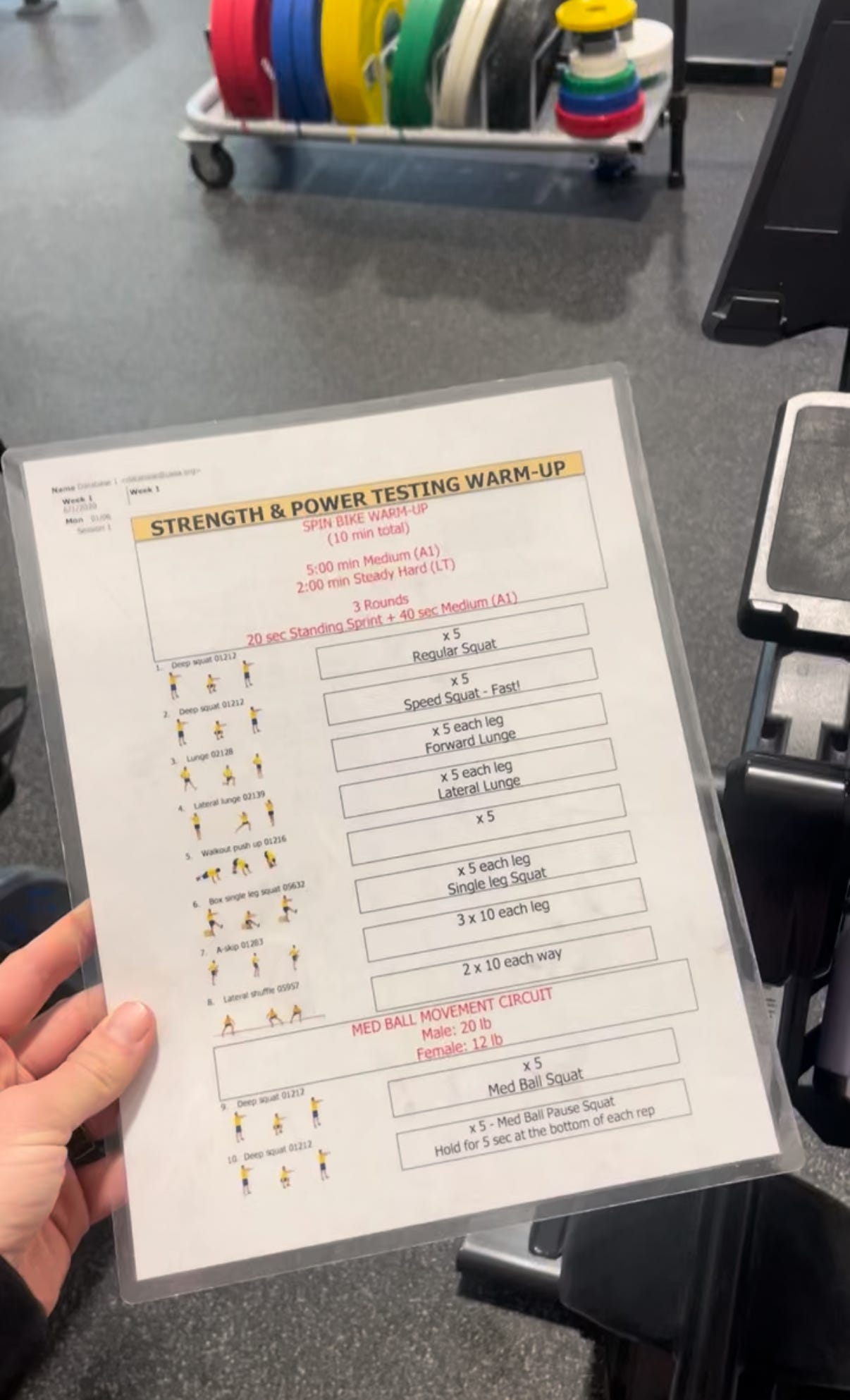If I could train on snow year round, I think I would be a lot better ski racer. But unfortunately, both mother nature and our team’s budget preclude this. So we spend the off season focused primarily on getting stronger and priming our bodies to maximize the limited on snow time we do get.
This time in the gym is incredibly important, and even if I could ski all year round, I would still take the dry land workouts just as serious. Physical strength is a massive part of what makes the best athletes so fast, even though skiing is a skill sport.
Two weeks ago, I was in Park City for our annual spring physical testing and I thought it could be fun to dive into what this testing includes, why we do it and what it means for our dry land training.
I’ll start by running through a step by step of each of the tests and explaining a bit of the logic behind them and finish with photos and videos at the bottom!
How the two‑day testing schedule is set up
We spend only a handful of hours training on snow in the summer months before our season starts, so every decision in the gym has to count. That’s why Per Lundstam, our Head of High Performance, built our program around a very simple goal: in roughly ninety seconds—the length of a World Cup run—how can we produce and absorb more work than anyone else.
Most of our women’s‑team (precluding injuries) go through the same 2 day testing protocol, once in the spring and again in the fall (and sometimes a mid summer testing check in as well). Day 1 covers output and control; Day 2 focuses on how long we can hold power under stress.
Day 1 — strength, power, control
We usually get to the COE (the us ski team’s main headquarters in Park City, UT) around 8 am. I start by getting an in-body scan, which is a non-invasive body composition analysis test (you stand barefoot on a machine with electrodes) that uses bioelectrical impedance analysis (BIA) to measure body fat percentage, lean body mass, and total body water.
Then I eat a small breakfast (toast and peanut butter or something similar) and get started warming up shortly after. 10 mins of spin biking followed by a standardized warm up that takes about 10-20 minutes and is meant to prepare us for maximal strength and power output during the different tests.
The first real tests are the Counter‑Movement jumps (with a wooden dowel on our back, we start standing, squat down and jump up as high as possible), Static jumps (same set up but start in squatted position), Weighted Counter‑Movement (same as the first ones, but with a 35/45 lb bar instead of the dowel) Drop Jumps (step off a ~1 ft box and jump up with dowel), and single leg jumps. These tests:
Evaluate the power output profile and create the force/velocity curve for each athlete to determine how much strength training versus velocity bias training the athlete should conduct.
Tell us whether we need more heavy lifting or more spring‑type exercises by showing how much force you can put into the ground at different speeds.
Then we have
Dynamic RSI (Reactive Strength Index) - 20 stiff legged fast pogo jumps.
Investigate the athletes ability to generate as much force in as short time as possible in order to determine the athletes system “stiffness” in order to lessen the force leakage during movement.
Think of it as a “bounce test.” The quicker and higher you rebound, the better you’ll hold an edge without losing energy.
Isometric Max‑Strength Test (ISO Squat) - A static push against an immovable bar shows your raw leg strength without any fancy technique.
Determine max contractile ability in lower limb musculature during isometric contraction.
for all of these tests we have a couple practice reps and then a couple recorded tests with a few minutes in between for rest.
Isometric Abduction/Adduction Hip Assessment
Investigate balance and strength in hip musculature.
Checks hip strength and whether both hips are equally strong
Hamstring Assessment - measures hamstring strength and resistance.
Agility Test - A 20 m shuttle run zig zagging around cones that shows how fast and smoothly you can change direction.
Test the athletes ability to produce non‑linear speed and assess the coordinative patterns in movement application and velocity.
Dynamic–Explosive Abdominal Rotational Med‑Ball Test - How hard you can sling a med‑ball sideways to assess core strength
Measure rotational explosive strength and stability components to generate max explosive rotational trunk ability.
Max‑Strength Test, Single‑Leg Squat on High Box (Smith Rack)
Determine the athletes maximal strength in the lower body similar to the maximal back squat but removing one leg lessens the axial load in the spine and potentially over time we can decrease the lower back issues associated with ski racers.
A heavy one‑leg squat reveals side‑to‑side strength differences
Aerobic Efficiency (lactic acid) Bike Test - we take our lactic acid measurements while wattage increases every 5 mins to determine our a1, a2 and lactic threshold zones.
Investigate aerobic efficiency and energy system contribution to physiological work and human locomotion.
shows how much power you can put out before lactate builds—basically, how big your “easy‑breathing” engine is.
Day 2 — structure, vision, energy systems
Vision Assessment - a number of different reflex and eye tests
Assess general and performance‑related vision characteristics for baseline and potential performance profiling in the athletes.
These include contrast, depth perception, tracking, proprioception, reaction, focus and more.
Blood testing - we didn’t do blood testing this year, but we have in the past. It’s not incredibly comprehensive, but measures things like ferritin and hemoglobin and important electrolytes.
Anaerobic Capacity Assessment - the very hardest test! All out on the windgate bike (a spin bike with a torque factor)
Evaluate acidosis tolerance and power output during high metabolic demands, 90 sec Wingate testing while looking at oxygen delivery chain and kinetics.
Four brutal 90‑second sprints on the bike (with 10 min break in between) that mimic a race run and show how much power you can make—and survive—when your legs are on fire.
Muscle‑Endurance Test, Leg‑Press + Jumps
Using the instrumented and developed SEGR leg‑press (a very specialized leg press machine - see video below), the athletes are assessed in terms of muscular endurance in concentric and eccentric muscle contractions.
The testing protocol for this one is 5 ‘jumps’ in the leg press where you’re pushing off as hard as possible, followed by twenty heavy leg‑press reps (concentric and eccentric) and then 5 more jumps to see if your legs can stay strong all the way to the finish on race day.
And by the end you are totally cooked!
The hardest part is showing up to day 2 for the anaerobic capacity test (the 4 by 90 second all out test on the bike) feeling sore and fatigued from the day before. But it’s so much better to do it with teammates and all of my past tests have felt relatively ‘fun’. Of course, we all get competitive with each other, but also want to keep outperforming ourselves each year as well (which definitely gets harder as you get older).
The spring tests are meant to be a baseline for the summer and to determine where we should focus our offseason training, and the fall tests are meant to assess how the summer training went and make any last minute adjustments before the season starts.
Ironically, most people’s jumps (velocity) are best in the spring after a season of skiing, because skiing is so power based. It can be a bit hard to work out all summer long and see your testing numbers go down on some things (which happened to me last summer with our mid season testing), which is why it’s very important (for me at least) to be super clear on the goal and know that you may have to take a step back on one thing to take two steps forward on another thing down the road.
I am very much a Type II (fast twitch)‑dominant athlete —meaning my muscle fibers fire quickly and generate a lot of force in a short burst. They rely on stored sugar inside the muscle, so they’re great for explosive efforts—jumps, sprints, that hard push on the ski when I hit the fall‑line. The trade‑off is they fatigue sooner and create more lactate.
For example, on the anaerobic bike test, I averaged north of 400 watts for three of the four 90‑second bouts and watched my blood‑lactate climb all the way to 22 mM on the final rep. That kind of spike tells us my buffering system can handle serious acidity without shutting down, which is exactly what you need on a steep Super‑G set when your legs are firing and the course still has thirty gates to go.
This is great to have for skiing, but I am trying to build more Type I capacity (the slow‑twitch fibers that burn fat and keep lactate down)/my aerobic base a bit since I tend to have slower splits at the bottom of courses. This will be the focus this summer, and I’m confident I can increase my base while maintaining my power.
I’m also working to push overall strength higher which means mixing heavy lower‑body lifts with long Zone 2 rides and tempo sessions: the barbell keeps the horsepower alive; the easy‑aerobic work grows the gas tank underneath it.
The balance is delicate—too much aerobic focus and I risk dulling the fast‑twitch edge; too much pure power work and I don’t shift the lactate curve. The goal is to land in the middle: optimize what already sets me apart, raise the floor on strength and endurance, and show up on race day a little heavier, a little stronger, and just as quick.
Now for the photos!
the COE testing room where most of our tests take place:

lol at my face during jumps :p this is the non-weighted counter movement jump on the force plates.
here is a static movement jump with a view of the screen showing all the numbers (height, velocity, force etc)
This is Jett (on the men’s team) doing the iso force plate test - basically push as hard as possible into the bar.
here is Keely starting her aerobic bike test (the 5 minute ramp test)- it starts off nice and easy and then very quickly gets quite hard. You can technically stop whenever you get past a certain lactate (basically one session after it goes over 4), but we all usually try to push ourselves to our limit, where we can’t pedal at the set wattage any more.
lots of finger pricks during these tests :)
next up is the hamstring test and the adductor and abductor test - have never not gotten a calf cramp while doing this one :/
here is a single leg smith rack test - this one is definitely a burner!
some years we also do range of motion testing but I’ve only done this once and there were no red flags (asymmetries)
followed by the very least fun test - the anaerobic capacity test :/ 90 seconds has never felt so long!
then we have the SEGR test: 5 jumps, 20 squats (push and resist) and 5 jumps
this one requires a bit of technique which I am not so good at, but getting better.










The amount of preparation and data analysis you do is unreal. World class athlete includes way more than just body. Really impressive.
Super interesting to see these all described. So much more sophisticated and ski racing specific than in my day. We had the wingate, vert jump, max vo2, body comp and then some basic calisthenics. Thanks for walking through it!